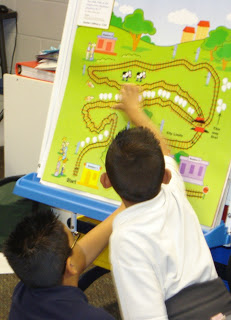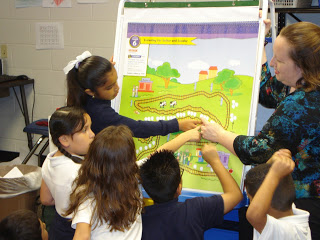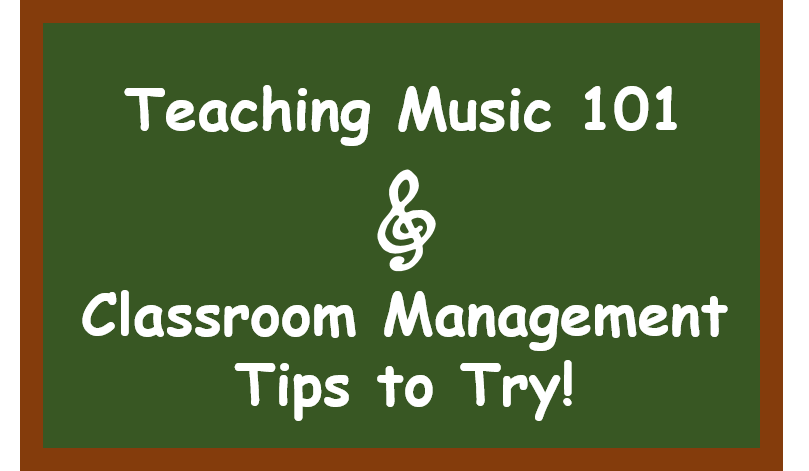This post is intended for anyone who is a new teacher, but especially music teachers because I am a music teacher, so all of my advice comes from that perspective.
Let me first tell you that although I have opinions I am no expert. Like all educators, teaching is something I practice. Now that I’m about to begin my 15th year of teaching I get it right more often that I used to but each victory that I’ve had in teaching has been a result a mound of personal reflection, refinement in my practice and most especially trial and error.
Confession Time
 So there I was in my second week of teaching EVER. Admittedly a little high from the glow of fake-out, friendly, zombie-perfect behavior that greeted me the entire first week of school.
So there I was in my second week of teaching EVER. Admittedly a little high from the glow of fake-out, friendly, zombie-perfect behavior that greeted me the entire first week of school.
My first graders were lined up and silent under the scrutiny of their veteran teacher and looking at me with hopeful faces. I smiled enthusiastically and said, “Come on in and make a sit down circle”. Then without a worry I held open the door
Imagine my SHOCK when they ran right past and NO ONE, not one student sat down in a sit down circle! In fact, as each student hit the door they sort of scattered to the four winds. At this point so early in the year, none of them were being particularly naughty, they were just placed in an intriguing environment and they wanted to explore. For some that meant, crawling under all the chairs I had lined up. For others that meant walking over to instruments and playing them. Still others decided that an empty space of floor was meant for running and rolling and playing tag. Once they were scattered I had no idea how to effectively get their attention. I could have yelled, but that really isn’t me.
Furthermore, when faced with the chaos of a off task class every idea, every objective, every song I had planned simply flew out of my head.
 So rather than do what I had planned OR start yelling I did things the hard way and spent the next 15 minutes trying to coax individual children into giving up the activity that interested them and sit on the floor where no on was doing anything interesting at all.
So rather than do what I had planned OR start yelling I did things the hard way and spent the next 15 minutes trying to coax individual children into giving up the activity that interested them and sit on the floor where no on was doing anything interesting at all.
It didn’t really work very well, but eventually after wasting way too much time, I finally got everyone sort of seated I was able to teach a little of what I had planned. But guess what? As soon as I finished an activity and tried to start something new, I was faced with scattered and off task students.
That second week of school and the weeks that followed were some of the most difficult days I ever had as a teacher.
My inability to direct my class behavior meant that I was rarely able to teach with the depth that was needed to help my students create meaning. When I would finally “wrestle” a class into a semblance of control, it would be time for them to leave and I’d have to start all over again with the next class.
To make matters worse, many times a plan that looked amazing on paper would fall apart in the classroom when I was faced with the actual developmental and instructional needs of my students. It didn’t always help to borrow my co-teachers plans because by that point, she had internalized many things that weren’t yet obvious to me. Additionally, when real behavior problems would arise I would sometimes make the situation worse because I didn’t yet know or understand how to recognize situations for what they were. I found myself over reacting to minor issues and underestimating serious ones and as such I was often the cause when behaviors escalated.
Being a new teacher is REALLY REALLY hard, but for me the hardest thing about being a new music teacher was the reality that for all of the music I knew, I didn’t yet know children, AND for all of the music education classes and student teaching I had done, I really didn’t know what would work.
That is enough confessing for one day. I could say more about HOW things got better for me mostly because of the investment my co-teachers made in me…. However, for now all I will say is that things WILL get better, you CAN be an excellent teacher!
So you’ve found this post perhaps because you are nervous about your ability to manage your class, OR you’ve got a few weeks under your belt and you are miserable! Either way, I think that these tips can help. By the way, although they are not in directly quoted, the biggest influence on my classroom mangment style comes from two sources. First, my students with the Richards Institute and their work with Education Through Music, AND secondly professional development based on the book that I’ve read called Love and Logic. Being a music teacher who lacks a home room means that follow through is a real challenge, but if you are familiar with the work you’ll see the influence in the list.
So here is my list of
10 classroom management tips for NEW music teachers
1. Tell them where to go – and demonstrate where and how. – Pick a place, any place, whatever place that fits your routine whether that be a place on the floor, in a group or in a circle, and invite the most dependable student to go and have a seat. Release them in small groups to follow. Anyone who doesn’t demonstrate the procedure gets to practice it again, right then. This will work for any class or any other time when you aren’t singing them into the room.
2. Sing them into class. Don’t be like I was when I started, choose a song or two or three that you can pull out when a class arrives. Start singing it in the hallway and have them follow you in singing and moving as you go. My favorite is “Come and Follow Me” from
ETM and their “Let’s Do it Again” collection. Songs like this are a great way to focus the attention on you, and “Come and Follow Me” allows you to set up for your next activity while you are still actively engaged in this song.
3. Be interesting . – When students get to school if they see me on campus, they ALWAYS ask, What are going to do today? I have gotten in the habit of answering, “Something really special that I just know you will enjoy.” The more excited you are, the more likely it is that students will enter your class ready and in anticipation. When you say something use your voice to inflect confidence that everyone will do as you ask. Don’t say, “if you want to read a book with me come and sit down.” What if they don’t want to? Instead, with as much excitement as you can muster on your face, say, “Look at what we are going to read!”
 4. Give instructions as if they will be obeyed
4. Give instructions as if they will be obeyed When you say something use your voice to inflect confidence that everyone will do as you ask. Let’s say that you’ve just finished the song “A-Tisket A Tasket” and now you want to share the recording by Ella Fitzgerald while looking at the children’s book for that song….. Don’t say, “if you want to read a book with me come and sit down.” What if they don’t want to? Instead, with as much excitement as you can muster on your face, say, “Look at what we are going to read!”

5. Teach the students who will – This really should be number one because if you can get this solved, then almost everything else will line itself out. My friends at the Richards Institute are really big into this idea. When I had my consultancy with Dr. Randal McChesney, THIS was what we concentrated on most. You see, it is VERY tempting for me to beg, cajole and threaten the 5-6 students in my class who don’t want to participate or who are trying to be disruptive. Instead, I am slowly but surely getting better at teaching the 5-6 students who always follow directions and I’m much happier. Now rather than the reluctant disruptive behaviors dragging the whole group down, the interested, engaged and enthusiastic behaviors are driving the class forward. Because I am attending and teaching to those students who will come with me, then those 10-12 students in the middle who might be swayed by misbehavior or disinterest are coming along and before long, even my students who might attempt open and hostile sabotage join us in learning.
6. Learn multiple ways to perform each song. – You just got done with an amazing beginning of the year in-service for music teachers. You learned several new songs and have decided to use some of them. You present “Down Down Baby” to your 4th grade class just like it was presented to you and it flops! Now what? The students are really loving the song, but it is obvious that to continue with the current set up will cause more problems. Well then it’s lucky that you are a smart cookie. On your way home from the in-service, you figured out 3 different way to play the game, each one more closely structured than the last. One of my favorite games to play is Rig-a-jig-jig. As much as I like it and want my students to play it, I can’t just start the game and let it go, otherwise it will disintegrate into chaos. Because ETM uses a version of Rig-a-jig-jig, I’ve learned several structures and I can choose the one that best fits the needs of the class.
7. Consider your room. – Is your room causing problems? Maybe you need to put things away. Maybe you need move the common supplies to an area more easily accessible. If you can’t move your supplies, then perhaps your room set up calls for a special procedure. In my room I didn’t really have a choice but to put some of the textbooks behind my desk. I chose 5th grade because they are generally more in control of their bodies and I can trust them. I also taught them a procedure so that when we passed out the books I didn’t end up with 10 people behind my desk wrestling over books. Remember those chairs that my sweet first graders crawled under my first few weeks of teaching? I put them away. I decided I would rather stack and restack my chairs rather than have them out when the younger students were there. As yourself if your room is set up for learning. Are all of your teaching materials where you can get to them without any fuss?
8. Play the “what if” game with your lessons – What if they’ve already learned this song what other song could we sing with the same tonal set? What if this game won’t work because we had to move the risers in? What if I don’t have enough books? What if the power goes out? What if the projector bulb burns out? What if Johnny cuts his finger on a xylophone, or what if the phone rings, or what if Sarah throws up? What if I have 15 minutes left in class and I’m done with my lesson? So much of the potential classroom management issues can be avoided with just a little forethought.
9. Practice bulldozing. One of the most popular ways for students to disrupt learning is to get the teacher off task. When you have a student determined to derail you from your teaching, it is VERY easy to be distracted. They will ask off topic questions, they will bother other students, they will get into things without permission, all to illicit your attention. You can be kind, but you don’t have to be put off. One of the most dangerous things a teacher can say to a class is “I’ll wait.” You may be waiting for silent attentiveness, but in the absence of interest neither the silence or attentiveness will ever come. Instead, plow ahead and get the students engaged in an activity who are ready. When the talking, disruptive and inattentive students miss out on something interesting they will take notice and either solve their behavior, or not. However, the students who are willing won’t be let down.
10. Invest in your future classes, by solving discipline problems out of class. For the last two years I have been blessed with morning duty. I love it because it gives me the chance to talk with students. During my morning duty time I target students who struggle in my class. I work at building relationships with them so that eventually we can talk about their behavior in class. Then when they come to class I meet them at the door and am often able to discreetly encourage them to do their best “for me.” When you teach music, it takes much much longer to reap those kinds of results because you don’t see your students every day. However, since you will be their teacher for several years, the investment is well worth the effort. Students are AMAZED when I attend their parents teacher conferences. They are ASTOUNDED when I call home, all because they aren’t expecting it. Invest in your relationship with a troubled student today and although you might not see any change this year or the next, it will happen.

 So there I was in my second week of teaching EVER. Admittedly a little high from the glow of fake-out, friendly, zombie-perfect behavior that greeted me the entire first week of school.
So there I was in my second week of teaching EVER. Admittedly a little high from the glow of fake-out, friendly, zombie-perfect behavior that greeted me the entire first week of school. So rather than do what I had planned OR start yelling I did things the hard way and spent the next 15 minutes trying to coax individual children into giving up the activity that interested them and sit on the floor where no on was doing anything interesting at all.
So rather than do what I had planned OR start yelling I did things the hard way and spent the next 15 minutes trying to coax individual children into giving up the activity that interested them and sit on the floor where no on was doing anything interesting at all. 4. Give instructions as if they will be obeyed When you say something use your voice to inflect confidence that everyone will do as you ask. Let’s say that you’ve just finished the song “A-Tisket A Tasket” and now you want to share the recording by Ella Fitzgerald while looking at the children’s book for that song….. Don’t say, “if you want to read a book with me come and sit down.” What if they don’t want to? Instead, with as much excitement as you can muster on your face, say, “Look at what we are going to read!”
4. Give instructions as if they will be obeyed When you say something use your voice to inflect confidence that everyone will do as you ask. Let’s say that you’ve just finished the song “A-Tisket A Tasket” and now you want to share the recording by Ella Fitzgerald while looking at the children’s book for that song….. Don’t say, “if you want to read a book with me come and sit down.” What if they don’t want to? Instead, with as much excitement as you can muster on your face, say, “Look at what we are going to read!”

Show no fear. I am in the Special Ed Room in the High School and even they are much older, there are some difficult days. Being a retired State Trooper to becoming a teacher is definitely a life changing experience. Anita
I teach kids with special needs and I teach all subjects except music. However, I can totally relate to your story and your points. Singing transitions is something that really helps my students move into new activities during the day.